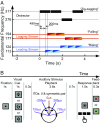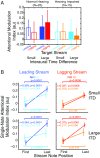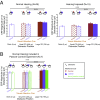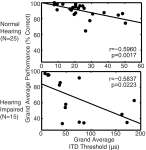Sensorineural hearing loss degrades behavioral and physiological measures of human spatial selective auditory attention
- PMID: 29555752
- PMCID: PMC5889663
- DOI: 10.1073/pnas.1721226115
Sensorineural hearing loss degrades behavioral and physiological measures of human spatial selective auditory attention
Abstract
Listeners with sensorineural hearing loss often have trouble understanding speech amid other voices. While poor spatial hearing is often implicated, direct evidence is weak; moreover, studies suggest that reduced audibility and degraded spectrotemporal coding may explain such problems. We hypothesized that poor spatial acuity leads to difficulty deploying selective attention, which normally filters out distracting sounds. In listeners with normal hearing, selective attention causes changes in the neural responses evoked by competing sounds, which can be used to quantify the effectiveness of attentional control. Here, we used behavior and electroencephalography to explore whether control of selective auditory attention is degraded in hearing-impaired (HI) listeners. Normal-hearing (NH) and HI listeners identified a simple melody presented simultaneously with two competing melodies, each simulated from different lateral angles. We quantified performance and attentional modulation of cortical responses evoked by these competing streams. Compared with NH listeners, HI listeners had poorer sensitivity to spatial cues, performed more poorly on the selective attention task, and showed less robust attentional modulation of cortical responses. Moreover, across NH and HI individuals, these measures were correlated. While both groups showed cortical suppression of distracting streams, this modulation was weaker in HI listeners, especially when attending to a target at midline, surrounded by competing streams. These findings suggest that hearing loss interferes with the ability to filter out sound sources based on location, contributing to communication difficulties in social situations. These findings also have implications for technologies aiming to use neural signals to guide hearing aid processing.
Keywords: binaural hearing; electroencephalography; hearing impairment.
Copyright © 2018 the Author(s). Published by PNAS.
Conflict of interest statement
The authors declare no conflict of interest.
Figures







References
-
- Colburn HS. Binaural interaction and localization with various hearing impairments. Scand Audiol Suppl. 1982;15:27–45. - PubMed
-
- Mackersie CL, Prida TL, Stiles D. The role of sequential stream segregation and frequency selectivity in the perception of simultaneous sentences by listeners with sensorineural hearing loss. J Speech Lang Hear Res. 2001;44:19–28. - PubMed
-
- Strelcyk O, Dau T. Relations between frequency selectivity, temporal fine-structure processing, and speech reception in impaired hearing. J Acoust Soc Am. 2009;125:3328–3345. - PubMed
Publication types
MeSH terms
Grants and funding
LinkOut - more resources
Full Text Sources
Other Literature Sources

